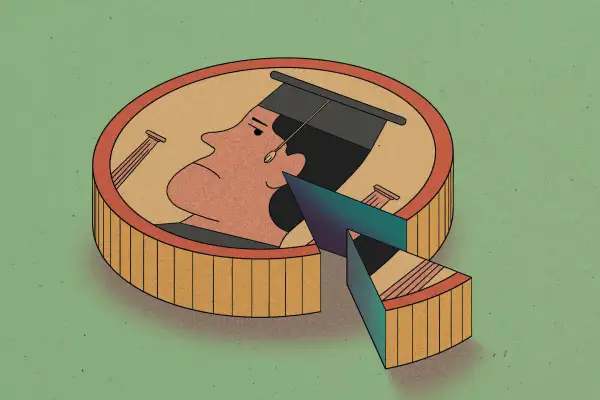Here's How Much of Your Income Should Go to Student Loans Each Month

Ask financial experts how much of your monthly income should go toward, say, housing, and you’re likely to get a quick response: 30% or less. Try asking them the same question, except about student loan payments, and you'll likely hear "well, it depends."
So how much of your income should you actually be putting toward student loans each month in an ideal budget? While there’s no hard-and-fast rule like there is for housing, the answer is no less important to know.
Now that the student loan moratorium is ending after pausing interest accrual and student loan payments for more than 40 months, it’s an especially great time for borrowers to think out how their loan payments fit into their overall financial picture.
First, let's review the general rules of thumb that do exist. Experts often recommend that students not borrow more than 8% to 10% of their projected monthly gross income or 20% of their “discretionary income.” On the other hand, the Consumer Financial Protection Bureau (CFPB) says students should not borrow more than their expected starting salary one year after graduation.
For example, if the starting annual salary for a chemical engineer is $62,000, your total student loan amount should not exceed that number.
The problem so far is that many students borrow without understanding prospective salaries for their career path, nor do they understand the difference between discretionary, take-home or gross income. Sometimes they don’t know until they graduate how much student loan debt they’ve accrued.
Whether you’re a student trying to figure out how much you can afford to borrow, or you graduated years ago and are simply trying to get a handle on your loans, some basic budgeting fundamentals can help you balance student debt with other financial needs and goals.
Here’s what financial planners say you should know about budgeting for student loan payments.
Determine your budget
Start with your total monthly income. After subtracting deductions including federal and state taxes, Social Security and Medicare taxes, and pre-tax contributions to employer-based healthcare and retirement funds, you have your net income, says Patti Hughes, owner of Lake Life Wealth Advisory Group in Chicago. That’s the money that hits your bank account, and that’s what you’ve got to live (and budget) off of.
Find the budgeting rule that works for you
Once you have your net income figure, there are a few different ways to divvy up your money. A common one is the 50/30/20 rule, a starting point that some financial planners use to develop budgets.
The rule breaks down accordingly:
- 50%: basic/fixed needs (rent, utilities, transportation, insurance, health care, car payment, minimum loan payments)
- 30%: wants or variable expenses (dining out, clothing, cable subscription, entertainment, travel)
- 20%: savings and debt (emergency savings, additional debt payments)
But to tackle larger debt, both student loan and credit card, experts say you’ll likely need to reduce expenses to find at least 15% in your budget to pay for debt. It may mean reducing variable expenses, or if your housing costs are high, it could mean moving to a cheaper place, taking in a roommate, or even moving home for a period. If you can’t cut expenses, then your other option is taking on a side hustle to bring in more money.
Instead of forcing your budget into the 50/30/20 breakdown, some financial planners instead tweak the rule to better reflect the reality that millions of Americans owe five- or six-figure student debt.
Hughes, for example, uses a 60/20/20 breakdown to create a budget:
- 60% fixed needs (includes monthly student loan payment and credit card payment if used for fixed expenses)
- 20% variable/discretionary expenses
- 20% savings and debt (if already saving 15% in your 401(k), put this 20% toward emergency savings, college savings and extra debt payments)
Lauryn Williams, the founder of the financial planning firm Worth Winning, uses a slightly different version, the 50/15/15/20 breakdown.
- 50%: fixed expenses (including car payment and possibly minimum student loan payment if budget allows)
- 15%: debt (credit card and student loan)
- 15%: savings in an emergency fund (assuming you’re already contributing to a 401(k))
- 20%: variable/discretionary expenses (she puts groceries here)
Everyone’s budget will be slightly different so take these percentages as guidelines. Some expenses that may seem non-negotiable to you could be easy to cut for someone else. Williams suggests imagining you lost your job to identify your fixed expenses and which variable expenses can be cut or adjusted. For example, to look for a new job, you’d still need your phone and internet, and possibly a car.
Calculate how much your loan costs each month
Sometimes, it’s easier (or necessary, if you don’t have a job yet) to figure out your monthly loan payment first and then determine what your ideal budget would look like. Hughes typically starts here when working with clients.
Let’s say you just graduated with $27,000 in undergraduate federal student loans. On a 10-year standard repayment plan with a 5.5% student loan interest rate, your monthly payment is about $293.
To meet this payment comfortably — at the recommended 8% gross salary limit — your minimum salary must be nearly $44,000, according to Mapping Your Future's student payment calculator. One reason it's smart to focus on your monthly payments (as opposed to your total amount) is that your repayment term and interest rate could drastically change how much you owe on a monthly basis.
If you’re earning more and $293 per month feels easy, that’s great — but it’s important not to skip building your emergency fund at the same time as paying down your debt, experts say. Tempting as it is to pay off student loans, it’s crucial to “put on your own oxygen mask first,” Williams says. And if you carry high-interest credit card debt, that’s more important to pay off before throwing extra money at student loans, which have low interest rates by comparison.
On the other hand, if you’re earning a low salary that makes federal loan payments on the default 10-year-plan uncomfortably high, an income-driven repayment plan can help lower your payments. You can see what your monthly payments would be with loan calculators or Federal Student Aid's loan simulator. Remember, private student loans — i.e. loans from private lenders and not the Department of Education — don’t qualify for federal repayment plans (or any potential federal student loan forgiveness programs).
If you do have private student loans, you'll have to refinance your student loans to change your loan term or interest rate.
What to know about payments on an income-driven repayment plan
An income-driven repayment (IDR) plan can be key if the numbers don’t add up under the standard student loan repayment plan for federal student loans.
In June, the Education Department unveiled a new IDR plan that is far more generous than the previous income-based plans through the federal agency. Under the new plan — dubbed Saving on a Valuable Education or SAVE — more of a borrower's income is protected from the formula that sets monthly payments.
Under the older plans, anything above 150% of the federal poverty line counted as income toward your payments. With the new plan, that threshold rises to 225% of the federal poverty line. Next year, additional benefits of the plan kick in, including reducing monthly payments on undergraduate loans to 5% of the borrower's "discretionary income," down from 10%.
All income-driven plans offer loan forgiveness after a certain number of years, and the new SAVE plan will be better for many borrowers on that front, too. Those who borrowed $12,000 or less make payments for 10 years and the remaining balance is forgiven. For balances above that amount, borrowers will have to make additional payments — for a maximum of 25 years. And that's if they have to make any payments at all. According to the Education Department, single borrowers who earn $32,800 or less may qualify for monthly payments of zero.
(Borrowers already in a standard repayment plan or in enrolled in PAYE, IBR and ICR can switch to the new SAVE plan; loan consolidation may be required. Those in the REPAYE plan are automatically moved over to SAVE.)
If you’re able, Hughes says contributing more to your 401(k) lowers your adjusted gross income, and in turn lowers your payment amount on an income-driven repayment plan even further. Keep in mind, at the end of repayment term, you may need to pay taxes on the forgiven amount, unless Congress extends a tax-free exemption that's set to expire in 2025.
Before you borrow, research career salaries
If college is still in your future, the best plan to avoid getting in over your head is to research prospective salaries for your career path. Then work backward to determine how much you can afford to borrow. That also helps you determine which colleges are more affordable, Williams says.
Limiting borrowing for graduate or professional programs (medicine, law, dental school) may be trickier, but knowing possible debt outcomes still helps you plan your career path. Hughes recommends using salary sites like Glassdoor or Payscale as a starting point.
Note: This article was originally reported and published in February 2021. It was updated with new information on President Biden's income-driven repayment plan, student loan interest rates and other key developments.'
More from Money
The Best Colleges in America 2023

